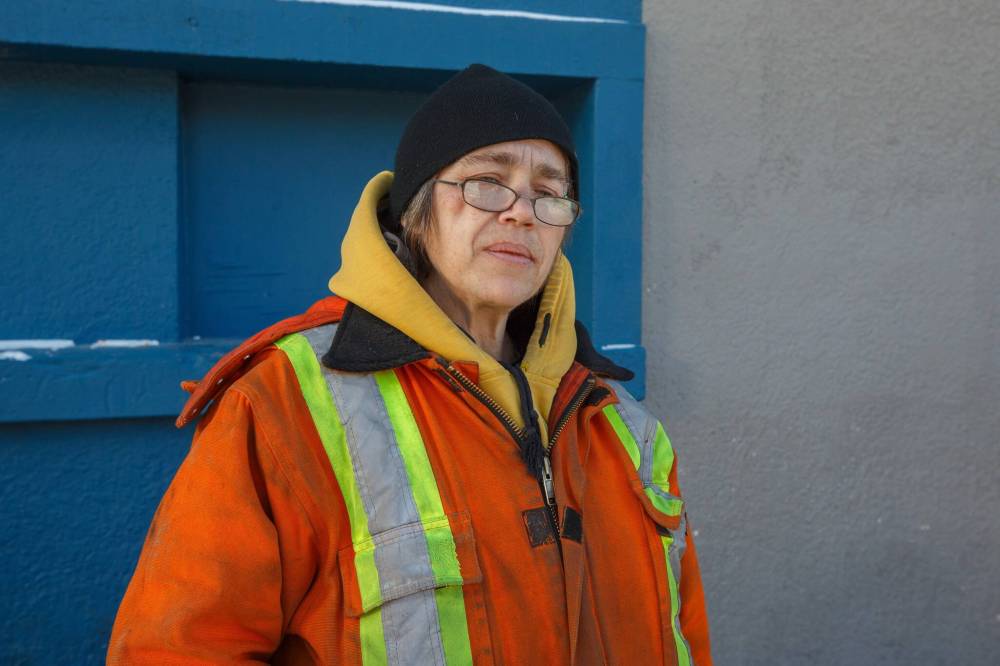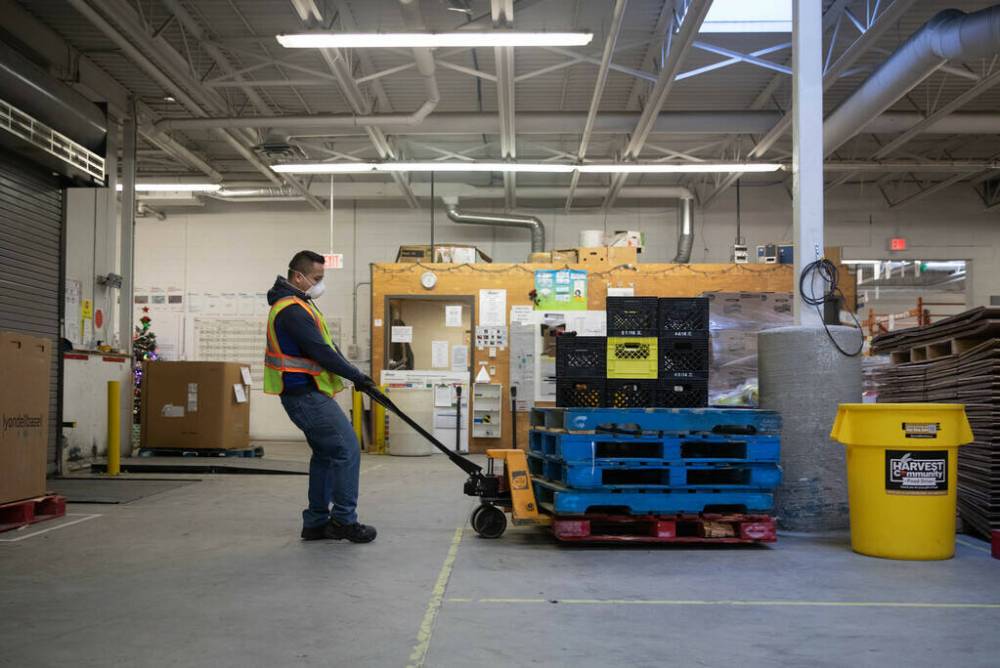Desperate times, depleted charities Rising cost of living leading more Winnipeggers to seek help from food banks, which are also hurting
Read this article for free:
or
Already have an account? Log in here »
To continue reading, please subscribe:
Monthly Digital Subscription
$0 for the first 4 weeks*
- Enjoy unlimited reading on winnipegfreepress.com
- Read the E-Edition, our digital replica newspaper
- Access News Break, our award-winning app
- Play interactive puzzles
*No charge for 4 weeks then price increases to the regular rate of $19.00 plus GST every four weeks. Offer available to new and qualified returning subscribers only. Cancel any time.
Monthly Digital Subscription
$4.75/week*
- Enjoy unlimited reading on winnipegfreepress.com
- Read the E-Edition, our digital replica newspaper
- Access News Break, our award-winning app
- Play interactive puzzles
*Billed as $19 plus GST every four weeks. Cancel any time.
To continue reading, please subscribe:
Add Free Press access to your Brandon Sun subscription for only an additional
$1 for the first 4 weeks*
*Your next subscription payment will increase by $1.00 and you will be charged $16.99 plus GST for four weeks. After four weeks, your payment will increase to $23.99 plus GST every four weeks.
Read unlimited articles for free today:
or
Already have an account? Log in here »
Hey there, time traveller!
This article was published 01/12/2022 (1101 days ago), so information in it may no longer be current.
Christina Dewitt has finally been able to put a roof over her head after becoming homeless during the pandemic, but still goes without food some days.
Dewitt, 45, lost her job in Carberry during the pandemic and she came to Winnipeg searching for work. She was the victim of a violent assault, and at that point, in her words, her life “kind of went down” and she found herself on the streets. She was able to find housing three months ago, and has been looking for work — in construction, she hopes — ever since.
As she told her story, she was waiting in line outside in the cold to receive a meal hamper from a Furby Street food bank. Going without meals to get by in between support from friends and charities, she said, is a constant in her life.
“Before I come here, I usually spend that week — if it wasn’t for friends — going without food,” she said Thursday afternoon.
MIKE DEAL / WINNIPEG FREE PRESS Going without meals to get by in between support from friends and charities, Christina Dewitt said, is a constant in her life.
Dewitt is optimistic by nature. Despite her hardships, she said, things are looking up, and she hopes when she finds work, she’ll be able to eat regular meals and even give back to the places that helped her through turbulent times.
“When I have the money, I’ll donate to this no matter what,” she said. “I like to see people have, even if I can’t.”
As inflation has pushed the cost of living higher and higher over the past year, the level of food insecurity across Winnipeg has skyrocketed, the numbers of both donations and volunteers has dropped and the demographics of people using food banks have shifted in a short amount of time.
Harvest Manitoba released Harvest Voices 2022, its second yearly summary of people using its support services Thursday, and the numbers show a significant spike in demand.
Harvest now feeds 90,000 people every month through its various programs, 10,000 more than just a year ago.
“It’s alarming, and it’s somewhat surprising to just continuously see these numbers rise,” said Meaghan Erbus, who worked on the report. “We’ve been so lucky to have the support of the community to be able to do our job and continue to do our job, even with this influx of folks. But we know that food banks can only offer so much in terms of food support.”
Food bank usage in Winnipeg has doubled since 2019, and more than 15,000 of its monthly visitors are children — the highest number Harvest has ever seen.
The report revealed that one of every four people visiting food banks has a job, a 50 per cent increase compared to last year. Of that number, just under half work full time.
“It’s alarming, and it’s somewhat surprising to just continuously see these numbers rise.”–Meaghan Erbus
“The types of employment that they had were sort of work that you might not think about,” Erbus said, offering health-care aides and educational assistants as examples of recent food-bank clients.
“Maybe jobs you wouldn’t typically think of folks then needing to access services of food banks.”
Food inflation in Canada hit 11.4 per cent in September, a 30-year high, leaving Harvest and other charities in difficult circumstances.
Some corporate donors are cost-cutting by doing away with large community gifts. Many people who donated — money, food and time — previously are no longer in a position to continue.
Harvest has increased the number of hampers it provides each month by 40 per cent — from 11,000 this time last year to about 15,000 now — forcing support organizations to get creative to pick up the slack.
JESSICA LEE / FREE PRESS FILES Manitoba Harvest has increased the number of hampers it provides each month by 40 per cent. 
Harvest is buying more food than ever to supplement lost donations, and has created a shopping option where visitors can purchase additional items to customize their hampers.
It’s a “pivotal” time for the non-profit sector and food banks, Erbus said. If the need continues to increase, the gap-plugging now being relied upon won’t likely be sustainable.
She said she hopes solutions come in the form of wider investments in the communities they serve. Increased employment income assistance, more affordable child care and expanded equal-opportunity employment training are just a few examples.
“That means that we also need some support from all levels of government, and sort of really thinking about it — what kind of province do we want to live in?” she said.
Winnipeggers are looking for help now in numbers United Way CEO Connie Walker has never seen before.
“More people reaching out with anxiety, depression, and I would say universally, just a greater sense of despair from many more community members.”–Connie Walker
Two years ago, United Way began providing Canada-wide access to the 211 phone service, which connects people in need to a variety of support services. In recent months, the organization has seen 300 Manitobans calling each week and about 8,750 searches for resources through the 211 website.
A recent call from inside the province came from someone working in a storage facility hoping to access help for someone who was living inside one of the units.
Calls like those have made it clear there’s people in desperate need across the province, Walker said.
“More people (are) reaching out needing food, more people are reaching out with financial insecurity, they can’t make their rent, worried about becoming homeless, more people reaching out with anxiety, depression, and I would say universally, just a greater sense of despair from many more community members,” she said.
Siloam Mission served twice as many meals in October as it did in September.
MIKAELA MACKENZIE / FREE PRESS FILES Siloam Mission served twice as many meals in October as it did in September.
A year ago, seemingly emerging from the additional hardships caused by the pandemic, the people running Siloam thought things were getting back closer to normal levels of fundraising and donations.
But significantly fewer people are showing up to help and donations haven’t picked up again, spokesperson Luke Thiessen said.
“This is probably the most challenging environment we’ve seen in recent memory on that front,” he said.
“Every month, every season, it feels like it’s getting a little bit harder to try and bring in the same amount of goods (and) food donations.”
Siloam has had to improvise. When short of volunteers, staff fills in. When short of food, they’ll pull from their own funds to make meals. But if the approximately 10 per cent of food they purchase themselves jumps to 20 per cent or beyond to meet the need, they will have to “make some hard decisions.”
“Turning people away is not an option.”–Luke Thiessen
“Turning people away is not an option. If there’s any other way for us to make that work, we’re going to make that work,” Thiessen said. “But certainly, if this is a long-term trend, that’s unsustainable.”
Harvest Manitoba’s report included the thousands of Ukrainian newcomers to Manitoba as a part of the group of new food bank users.
One of them was just a few spots ahead of Dewitt, visiting a food bank for the very first time after arriving in Winnipeg two months ago.
MIKE DEAL / WINNIPEG FREE PRESS Kate Petrovska said she hoped to receive vegetables and other healthy food, maybe even meat, if possible.
Kate Petrovska, 27, said she hoped to receive vegetables and other healthy food, maybe even meat, if possible.
“In Ukraine, we try (to eat) only healthy food. But here, because the price is very high, we started to buy some things less (healthy),” she said.
Like Dewitt, she and her boyfriend are also looking for work, and are optimistic their luck will change.
“It’s very expensive here…. We thought it will be expensive, but not like this,” she said.
malak.abas@freepress.mb.ca
As the weather gets increasingly colder, support groups for Manitoba’s most vulnerable groups are working together to support people who may spend a lot of time outdoors.
End Homelessness Winnipeg’s Extreme Weather Response committee released a winter weather response plan Thursday and announced more funds would be going to an additional 24/7 outreach van to do wellness checks and to pop-up camps led by Sabe Peace Walers to support people when the temperature plunges.
A winter response fund was also included in the plan, which will be distributed to community organizations that provide emergency services in freezing weather.
Many groups that provide meals and hampers also provide winter clothing to their visitors. Both Siloam Mission and United Way listed donations of winter clothing, including boots and coats as a critical need.
“Especially with this cold snap,” Siloam Mission spokesperson Luke Thiessen said.
“There are people who kind of managed to hold on with layers of seasonal clothing, but when we start to get these temperatures dropping below -15 C, -20 C, we’re going through a lot of winter clothes.”
— Malak Abas

Our newsroom depends on a growing audience of readers to power our journalism. If you are not a paid reader, please consider becoming a subscriber.
Our newsroom depends on its audience of readers to power our journalism. Thank you for your support.
History
Updated on Thursday, December 1, 2022 7:52 PM CST: typo fixed









